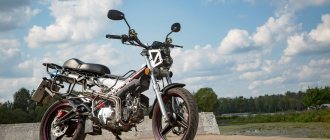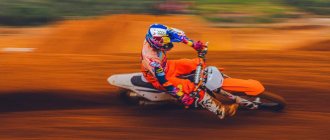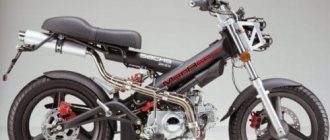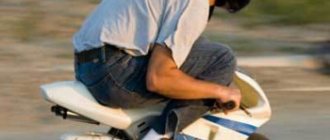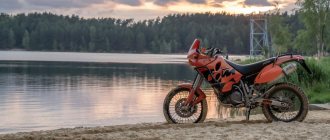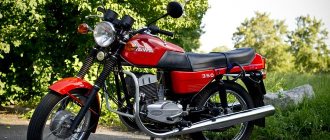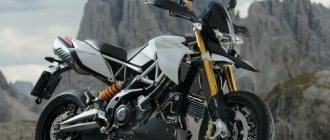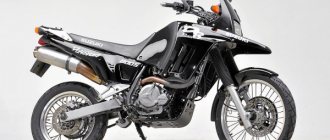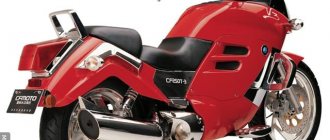BMW G650X
Model class : enduro, supermoto, scrambler
Years of production/sales : 2006-2009
BMW G650X series of motorcycles was first presented in 2006 at the Intermot exhibition in Cologne. This was a joint project between BMW and Aprilia - different models were created on the same engine and base, sold under the BMW and Aprilia brands. It is worth noting that such cooperation with the Italian company was not new - if we recall the F650 series, the first modifications (1993-2000) were also created with the participation of Aprilia - these were the BMW F650 Funduro and BMW F650ST (Strada) models, Aprilia had the Pegaso 650.
There were three models in the BMW G650X line:
- BMW G 650 Xmoto – motard version. It is distinguished by its appearance, road wheels and a powerful front brake (320 mm disc). The “big brother” of the model is the BMW HP2 Megamoto.
- BMW G 650 Xcountry – scrambler version (road motorcycle with the ability to ride on light off-road). It is distinguished by its appearance, round headlight, 19' and 17' spoked wheels and tires with a universal tread.
- BMW G 650 Xchallenge – enduro version. It is distinguished by its appearance, high front fender, engine protection, 21' and 18' spoked wheels and a removable license plate mount (together with turn signals).
The basis of the BMW G650X model series was the 1-cylinder Rotax injection engine, which was later also used on the BMW G650GS model. The engine produces 53 hp. power and 60 Nm of torque. Since 2008, this engine has been assembled in China, with the exception of the BMW G 650 Xmoto model - there, during the entire production period, only Austrian-assembled Rotax was installed there.
Among the features of the BMW G650X series, it is worth noting a steel frame, an inverted fork with a 45 mm diameter of stays, an adjustable rear suspension, a 5-speed gearbox, disc brakes and 156-60 kg of curb weight.
Models of the BMW G650X series were sold until 2009, after which they were discontinued. The series never received further development. Currently, only the BMW G650GS model with the same engine as the BMW G650X and the new BMW G310R remain on the market, but this is a completely different motorcycle in a different price category, which has nothing in common with the line of BMW G-series motorcycles.
Specifications
Comparative table of technical characteristics of BMW G650X series models:
| Models | BMW G 650 Xmoto | BMW G 650 Xcountry | BMW G 650 Xchallenge |
| Motorcycle type | motard | scrambler | enduro |
| engine's type | 1-cylinder 4-stroke | ||
| Working volume | 652 cc cm. | ||
| Cooling | liquid | ||
| Bore x Stroke | 100×83 mm | ||
| Compression ratio | 11,5:1 | ||
| Number of valves | DOHC, 4 valves per cylinder | ||
| Fuel supply system | injector | ||
| Ignition type | electronic | ||
| Maximum power | 53 hp at 7000 rpm | ||
| Maximum torque | 60 Nm at 5250 rpm | ||
| Frame | steel combined (aluminum back) | ||
| Transmission | 5-speed | ||
| type of drive | chain | ||
| Front tire size | 120/70 H 17 | 100/90 S 19 | 90/90 S 21 |
| Rear tire size | 160/60 H 17 | 130/80 S 17 | 140/80 S 18 |
| Front brakes | 1 disc, 320 mm, 4-piston caliper (optional ABS) | 1 disc, 300 mm, 2-piston caliper (optional ABS) | |
| Rear brakes | 1 disc, 240 mm, 1-piston caliper (optional ABS) | ||
| Front suspension | 45 mm inverted fork (adjustable compression and rebound), travel - 270 mm (240 mm - Xcountry version) | ||
| Rear suspension | pendulum, with monoshock absorber (adjustable preload and rebound), travel - 217 mm (Xcountry version - 210 mm, Xchallenge version - 270 mm) | ||
| Acceleration to 100 km/h (0-100) | 4.03 sec | ||
| Maximum speed | 165-170 km/h | ||
| Fuel tank capacity | 9.5 l | ||
| Motorcycle weight (curb) | 159 kg | 160 kg | 156 kg |
Energetic character for pure pleasure – the new BMW R 1200 R
This roadster is versatile on asphalt. A powerful, dynamic corner eater on the one hand, a comfortable and respectable travel companion on the other. Fully tailored to your needs, with the possibility of providing exceptional individuality with a huge range of accessories, in full accordance with the tastes of motorcyclists: either as a sports motorcycle, as a classic motorcycle, or even as a naked touring motorcycle: the BMW R 1200 R will always be yours faithful companion. The noble appearance attracts the eye; you can literally see and feel the care in detail in everything. Typical BMW, proven and always excellent quality, which you no longer want to give up once you have experienced it at least once.
The 1200 cc boxer engine makes its significant contribution. It is beyond any doubt - 109 hp. and 115 Nm majestically and powerfully carry it forward like never before. The excellent chassis copes well with 223 kg (with a full tank) - even when you load the bike with more, you can still enjoy light and distinct handling. The combination of exemplary safety equipment and timeless, but at the same time modern, high-quality and sporty design makes the BMW R 1200 R a motorcycle with unique capabilities.
So, let me introduce the BMW R 1200 R: modern power, exclusive looks, classic nakedness.
Engine
Construction type Air/oil-cooled flat twin ('Boxer') 4-stroke, one camshaft and four valves per cylinder, central balancer shaft Bore/Stroke 101 mm x 73 mm Working volume 1,170 cc Rated power 80 kW (109 hp) at 7,500 rpm Max. torque 115 Nm at 6,000 rpm Compression ratio 12.0 : 1 Type of mixture formation / engine control system Electronic intake pipe injection/BMS-K digital engine management with overrun fuel cut-off, twin-spark ignition Exhaust gas cleaning Closed-loop 3-way catalytic converter, emission standard EU-3
Power reserve/consumption
Maximum speed Over 200 km/h Consumption per 100 kilometers at a constant pace of 90 km/h 4.1 l Consumption per 100 kilometers at a constant pace of 120 km/h 5.5 l Fuel type Unleaded premium, octane rumber 98 (RON), automatic knock control permits operation with minimum octane number 95 (RON)
Electrics
Generator three-phase alternator 600 W battery 12 V / 14 Ah, maintenance-free
Traction transmission
Clutch Single dry plate clutch, hydraulically operated Transmission Constant mesh 6-speed gearbox with helical gear teeth Drive unit Shaft drive
Chassis/brakes
Frame Two-section frame consisting of front and rear sections with load-bearing engine-gearbox unit Front wheel suspension BMW Motorrad Telelever; stanchion diameter 35 mm, central spring strut Rear wheel suspension Cast aluminum single-sided swing arm with BMW Motorrad Paralever; central spring strut, spring pre-load hydraulically adjustable (continuously variable) at handwheel; rebound damping adjustable Suspension travel front/rear 120 mm / 140 mm Base 1.495 mm Front fork offset 119 mm Fork angle 62.9° Wheels Cast aluminum Front Disc Size 3.50 x 17" Rear Disc Size 5.50 x 17" Front tire 120/70 ZR 17 Rear tire 180/55 ZR 17 Front brake Twin disc, floating brake discs, 320 mm diameter, four-piston fixed calipers Rear brake Single disc brake, diameter 265 mm, double-piston floating caliper ABS Optional extra: BMW Motorrad Integral ABS (part-integral) Dimensions/weight
Length 2.145 mm Width (by mirrors) 872 mm Height (without mirrors) 1.285 mm Seat height when unladen 800 mm (low seat: 770 mm, high seat: 830 mm) Length along the inner seam of the trousers when empty 1,800 mm (low seat: 1,760 mm, high seat: 1,860 mm) Curb weight with full tank 1) 223 kg Dry weight 2) 198 kg Maximum permissible weight 450 kg Additional load (standard) 227 kg Useful fuel tank volume 18.0 l From this reserve volume approx. 3.0 l 1) All measurements made in accordance with Directive 93/93/EWG with all operating fluids and materials, with the fuel tank filled to 90 percent of the usable volume 2) Empty weight without operating fluids and materials
PHOTO, VIDEO, CHARACTERISTICS OF
THE BMW R 1200R
R 1200R 2006 R 1200R 2008 R 1200RT 2005 R 1200RT 2007 2011 BMW R1200R – the ageless roadster received a “heart” transplant
As the experience of 2009 showed, using a powerful boxer in an attempt to get a cool sportbike is not the best idea for BMW. The HP2 Sport motorcycle turned out to be an interesting and original road bike, but its path to the race track is prohibited. However, this does not mean that the DOHC engine of the bike was created in vain - over time, it found its place in the R1200GS and R1200RT models (in 2010), and now it has also moved into the “body” of the classic R1200R roadster.
The modified engine with two overhead camshafts boasts a slightly increased operating range (from 8000 to 8500 rpm) compared to the previous SOHC engine, as well as good power indicators: maximums are 110 hp. and 119 Nm for power and torque, respectively.
However, the updated classic roadster for the 2011 season will boast more than just an engine. BMW will offer buyers two designs - the standard R1200R will be complemented by a Classic version. The latter will replace alloy wheels with spoked ones, and will also add a little chrome and pinstripes in the right places. The official presentation of the model will take place at the EICMA show in Milan, but it is unlikely that BMW will add anything new to the existing data other than cost.
New version of the BMW R 1200 R in classic style
For the new season, BMW Motorrad is offering the R 1200 R with even more character.
Bright design, new boxer engine with DOHC (Double Overhead Camshaft), high-tech chassis with patented Telelever and Paralever suspensions make this motorcycle a real rock and roll roadster that will be noticeable on any road. Don't hesitate, it will give you unforgettable emotions from riding on two wheels!
The classic lines and perfect shape of the metal fuel tank, chrome manifold and overall updated rear end speak of the strong character of this motorcycle. This applies to both the main model and the Classic version, which is the absolute embodiment of the rock and roll theme in the motorcycle. The R1200R Classic, among other things, features a classic black and white color scheme and plenty of chrome parts.
The air-cooled two-cylinder boxer engine impresses with more than just its deep sound. Following the recent debut of the DOHC boxer engine on the main R-series models, dual overhead camshafts and four radial valves per cylinder are now available in the R 1200 R. The motorcycle's operating power has increased to 81 kW (110 hp), and the torque the torque increased to 119 Nm. This means that the bike now accelerates even more easily from very low engine speeds, performing well in any driving situation.
Additional options and equipment available for these models range from active and passive safety systems such as ABS Integral, ASC, crankcase protection, to comfort-enhancing systems such as electronic suspension adjustment system (ESA II), a lightweight Akrapović sports muffler made of titanium, a high windshield, which is especially valuable for lovers of long trips, or, for example, chrome-plated cylinder head covers that will not leave lovers of classic motorcycles indifferent. The new Roadster premiered in Milan at the EICMA show, and now the countdown is on until March, when the rock 'n' roll Roadster will appear at a dealership in your city.
November 23, 2010
Dad, don't skid!
text from Motorreview No. 9, 2006:
.Stinger,
photo:
editorial archiveBMW R1200 R: 1170 cm3, 109 hp, 198 kg, € 17,200
Unconventional marketing moves have recently become commonplace for BMW Motorrad. The latest one looks like this: a classic “opposite” car with a very (very!) conservative appearance, stuffed to the limit with electronic systems. Among the latter – for the first time on a production motorcycle – are traction control and a tire pressure sensor.
To the Reichstag! The Bavarians began experimenting with “vivisection”, developing new classes of motorcycles, not a year or even 10 years ago. But for many years, the main profit came from classic motorcycles with the company’s traditional two-cylinder boxer engines. It’s just that in recent years the Germans have been carried away by innovation and completely forgotten about the model that has carried the index R...R for decades (as you know, the first letter means “opposite”, the last one means the type, namely Roadster). As a result, the “classic”, which had not changed for ten years, quietly left the stage. But the need for such a motorcycle has not gone away: BMW riders are conservative people to the extreme, at least in the largest German, French and American markets for the company. Leaving long-time fans without a classic dear to their hearts would be unforgivable for the company, at least from an image point of view. A new buyer is, of course, great, but to upset those who faithfully supported the sale of Bimmers all these years... Well, it’s the same as GAZ curtailing the production of the “regional committee” “3102”.
And the old people get old, in the literal sense of the word too. Therefore, in addition to the conservative appearance that was dear to their hearts, it was necessary to equip the device with various systems that would make their life easier. For example, monitoring tire pressure - we are no longer old enough to puff around with a pressure gauge. Moreover, such systems have been proven to perfection on cars, and as accessories on two-wheeled vehicles. So isn't it time to put one of these on a production motorcycle? As for the PBS (aka traction control), its non-use until now cannot be called anything other than a bungling by motorcycle manufacturers. All that is needed is to link the “brains” of engine control and ABS. Again, like on brand cars. Once again, the simplicity of the solution is confirmed by the price for this option: € 290 (in Europe), which is half the surcharge for electronic shock absorber control. (Yes, yes, this system is also included in the list of custom equipment!) Can you tell me why all this is needed? To raise the client’s self-esteem: they say, what a fancy moped I have? You shouldn't be doing that. Regardless of age, traditional BMW customers know how to drive, and not bad, and therefore get behind the wheel in any weather. And not only for an easy country walk, but also for banal daily trips to... Yeah, to social security, we were daydreaming. Didn't you want to join the bank's board? Or, say, in the Reich... Bundestag.
Conservatory But this is all from the category of additional equipment, like the heated grips and the ABS itself (as you know, the Bavarians include all this in the list of options, not standard equipment). As for the mechanical part, it is already well known. More precisely, its components are known. Among the mechanical innovations - only the rear subframe, “compressed” from above, in comparison with other “opposites” of the family, and, accordingly, a completely new “body kit”. Otherwise, from the 109-horsepower engine and transmission to the brakes and suspension, the design is identical to the R1200 ST, which was originally intended as an alternative to the Roadster for a less conservative buyer. It is characteristic that the very first ST, in 1984, had a similar positioning. True, at that time it was a classic R80 R with a body kit and exhaust system from the enduro R80 GS and did not contain a single extravagant twist in its appearance.
The design of the R1200 R, on the contrary, contains not only nothing avant-garde, but also nothing new. A long “tail”, a rounded gas tank, a classic headlight... It’s as if the last 10 years never happened, which changed the “face” of Bavarian motorcycles beyond recognition! Moreover, even an experienced “bimmerrider” will accept the design of the device as a version of its predecessor, the R1150 R, that did not go into production at the time, and one who is not too knowledgeable in the company’s model range will completely confuse it with the previous model. The true age of the motorcycle is revealed only by the brake light, the instrument panel with an LCD display (both are from the K1200 R, again, unification!) and the wheels. Even LED turn signals with white glass are an option, and also available only from next spring!
In general, admirers of “traditional BMW values” will be pleased. Moreover, both those who rushed around in the R90 S in the 70s, and those who, in their youth, could only dream of the shiny chrome R100 R of the early 90s - the last “true classic” of the company. The only people disappointed are those who expected the device to be released not as a “neoconservative”, but as a “stripped” version of the R1200 S. But no one bothers to replace the round headlight with optics from the same K 1200 R (I believe that BMW itself will offer this option at least as an option). And most importantly, it’s not evening yet. It is unlikely that the number of people wishing to get an opposite straight is so small that the Bavarians would pass this piece past their mouths...
Previous photo Next photo options
Model BMW R1200 R Start of release 2006 Dry weight, kg 198 Curb weight, kg 223 Length/width, mm 2145/872 Base, mm 1495 Seat height, mm 830/800/770 Ground clearance, mm n. d. Gas tank volume, mm 18 Front fork pitch/reach 62,9/119 Engine 1170 cm3, 4-stroke, 2-cylinder, opposed, OHC, 8 valves, air cooling Bore/Stroke 101x73 Supply system injection, 52 mm Compression ratio 12 Power 109 hp at 7500 rpm Torque 115 Nm at 6500 rpm Transmission mechanical, 6-speed, single-disc dry clutch, main drive by cardan shaft Frame steel tube truss Front suspension BMW Telelever, 120 mm stroke Rear suspension BMW Paralever, 140 mm stroke Front brake 2 discs, 320 mm, ABS Rear brake disk, 265 mm, ABS Front wheel 120/70–17 Rear wheel 180/55–17 Maximum speed Acceleration 0–100 km/h 3.6 s Fuel consumption 5.5 l/100 km (at 120 km/h) Electronically tested
text from Motoevue No. 7, 2007:
Vladimir Zdorov,
photo:
Dmitry IvaikinBMW R1200R: 2007, 1170 cm3, 109 hp, 169 kg, 250 km/h, € 18,460 (as standard)
The appearance of new products from the Bavarians has become as common as a weekly morning planning meeting, where, as usual, all children, like in a good fairy tale... No, not like that. As in harsh reality, the good Santa Claus, hiding under the guise of the editor-in-chief, will certainly give all employees many “gifts”, for which the definition of “lulya” is much more accurately suited. Therefore, another two-cylinder haven for German pensioners, with a slightly increased engine capacity compared to its predecessor, to be honest, did not arouse much enthusiasm in me at first. The only thing that made the test of this bastion of German conservatism interesting and added a little intrigue was the ASC system. In other words, if you don’t go into technical details and don’t pay attention to the games of marketers who use dozens of pages of praise to decipher this abbreviation, then we are talking about the traction control system. But before I begin to delve into the essence of its work, perhaps it is worth paying a little attention to the motorcycle itself. Roadster
In the company itself, it is not customary to use international terms to designate this class of motorcycles - that’s why we have the R1200R, no less than a roadster.
Although, perhaps, there is something in this definition from the truth, there is so much in this “Bavarian” car. The engine here is a supporting structure - why is it not an analogue of the supporting body in a car? In terms of the richness of electronics, the R1200R easily outperforms almost any production car, unless it’s some kind of... BMW seventh series. There is a sensor here, or rather, not even a sensor, but a tire pressure indicator. By pressing the corresponding button on the dashboard, you can get accurate information about the pressure in the front and rear wheels. If the pressure begins to drop, a warning will appear on the dashboard automatically. But this is only a small fraction of the possible benefits available to the owner of this two-wheeled vehicle. Now I’m going to swear dirty - ESA! Another fashionable thing that is not found on any production motorcycle, well, except BMW, of course. These three letters hide an electronically adjustable suspension with nine adjustment positions, ranging from super comfortable, let’s call it pro-American, and ending with an almost track setting. And all this, mind you, with a light press of a button. Well, it’s somehow inconvenient to even mention such little things as information about instantaneous and average fuel consumption, average travel speed, “outboard” temperature and a host of other data; it seems to go without saying. I almost forgot about such a convenient option as the gear indicator. It is also worth mentioning that you can order BMW GPS Navigator-2, however, this is no longer a factory option, but an accessory from dealers. In principle, the third generation version is now available, but it is still in the process of certification. ABS, which has already become an almost mandatory attribute for all two-wheeled products of the company, also hardly needs any introduction. By the way, the ABS here is of an integral type, partially tied to working together with ASC. By God, if you don’t read the beginning of the article, you can easily think that we are talking about some kind of latest development in the field of cars. But the whole point is that I have a very ordinary classic motorcycle on test, even if in Bavaria they will call it a roadster at least three times. I was very afraid that behind all this electronic tinsel there would be hidden an ordinary oppositionist, of whom the company has recently produced more than the Chinese children... Don’t say “gop”
However!
Who would have thought, because I have driven almost all two-cylinder BMW models, from the R1200GS to the sporty R1200S. Good engines, but, compared to the four-cylinder K series (K1200R, S and RS, respectively), they are still a little weak and somewhat uneven in their operation. And the predecessor of this series, the BMWR1150 Rockster, left me with no memories other than boredom. I don’t know what the company’s engineers did there, because on paper the engine has only 109 hp, compare, for example, with the same 125 in the R1200S, but I have never seen such juicy thrust in any two-cylinder Bavarian boxer engine before! Moreover, the engine does not blow out at all even at high (for a two-cylinder engine, of course) speeds. The Germans turned out to be simply an incredible machine! Despite the weight and size, I easily went to the karting track with my own time, shown on the Suzuki TL 1000R. It even ended up that I managed to rub the plastic cylinder protection a little. Moreover, if you remove the central stand that clings to anything and slightly finish the footpeg stops, you can easily improve the time by another one and a half to two seconds. But what am I talking about? In this situation, obviously, you will have to completely cut down the valve cover... And in general, what does the cover have to do with it? This is a roadster - a walking vehicle for the leisurely parade of German labor veterans who have retired. But the way the motorcycle rides on the go-kart track does not fit into this concept at all. Superbly tuned chassis and power unit performance! Still, absolute power indicators are not always decisive, and the BMW R1200R is the clearest confirmation of this. In other words, the engineers managed to achieve excellent elasticity and traction at low and medium speeds, while somehow managing not to lose the “tops”! In civilian use, this means ease of control, the motorcycle is completely ready to adapt to your style. Are you in a complacent and leisurely mood? The high torque of the power unit will easily help you move in sixth gear even from 50 km/h, and the electronically adjustable suspension, set to the maximum comfort position, will carefully protect your loins, strained during a hard day of work. Or you can do exactly the opposite - tighten the suspension and “throw” a couple of gears down... However, I got a little distracted by all this from the most interesting system of this device. So, ASC. How does it work? Theory
Touch sensors located on the front and rear wheels constantly monitor the difference in their speed, and if the rear wheel begins to noticeably advance the front, then ASC immediately comes into operation - the corresponding command is sent to the electronics, and the ignition timing gradually decreases, up to the limit stable engine operation.
If this is not enough, the system skips every fourth fuel injection. At the same time, ASC is by no means a soulless electronic dummy, working according to a single primitive program. Indeed, on an uneven road or under some other circumstances, the difference in wheel speed can be quite natural, and this point is also taken into account. By the way, as the company’s engineers note, the newest generation of ABS on this motorcycle also has the same intellectual abilities. However, I don’t think that knowing the exact performance of the new semi-integral ABS pumps or presenting the operating features of the traction control system bypass valves is the only and vital information that is so lacking for future potential buyers of the German concern’s products. These people care little about the brilliant solutions from the point of view of engineers and technologists that were first used on a motorcycle. They don't care at all how it works. But how it is perceived directly on the motorcycle, how it feels in motion and what it gives from a safety point of view is, of course, important to them. But in practice, everything happens approximately as follows - ASC begins to choke the engine if the rear wheel slips somewhere after 15–20 km/h, and before this speed, for example, on a dirt surface, the rear tire can easily slip. The behavior of a motorcycle on wet asphalt at the beginning of heavy rain is indicative, when, as is known, the coefficient of adhesion is the lowest. At a speed of 100 km/h, in third gear you turn off the full throttle and only notice that the engine is running unevenly and the orange light on the dashboard is blinking. However, no one has canceled the laws of physics - if at high speed in an inclined position the rear wheel ends up on a bitumen patch, sand or any other slippery surface, then by the time the system wakes up and begins to fight slippage in every possible way, this will no longer be relevant... What's the difference, what is the speed of rotation of the rear wheel relative to the front on a motorcycle lying by the side of the road?.. My favorite wheelie ASC (it seems that with the advent of electronics in the world of motorcycles, soon half of the articles will consist entirely of various abbreviations and Anglicisms) is also not welcoming - the motorcycle seems to be starting to rise up , but somewhere around a 30-degree climb, someone electronic decides for me that this is enough, and completely cuts off the engine. This is precisely the rare case when such a sharp limitation of traction can have extremely unfavorable consequences, but what I discussed above is pure sophistry, that is, lengthy reasoning that has nothing to do with reality, because the owner of a BMW and a wheelie is like Santa -Klaus and the poor Jewish lawyer. The first character, although rare, is still encountered, but the poor Jewish lawyer is an absolutely fictitious, ephemeral, smoky-illusory outline that can cause a fair amount of mistrust even among aliens. In the end, ASC simply turns off simply, but I would not recommend future buyers of the BMW R1200R to do this, because any negative aspects in the operation of this system can only be discovered by someone who is eternally dissatisfied with life, filled with bile and skepticism, mixed with a total distrust of anyone manufacturer, test pilot. An idle life
The motorcycle provided for testing was stuffed as much as possible with all possible factory options - a common practice for company representative offices when working with the press. Among all the numerous electronic splendor, a small tinted windshield costing a measly € 100 was simply lost. However, at speeds beyond 200 km/h, the low-visibility windshield (at least for the price) shows its full capabilities. The average German, looking at whom his parents sadly state that their son has not grown at all, is quite comparable to my dimensions (not grown - that’s about 191–193 cm and 100 kilograms of live weight). Obviously, this very piece of glass was “blown” under it, because even at 230 km/h the aerodynamic comfort could be considered acceptable. As for the operation of the suspension, which I usually dwell on in detail in any test, let me remind you here - you decide what kind of suspension you have, this is controlled by a button with the abbreviation ESA. And the efficiency of the braking mechanisms is so high that the Germans quite naturally made the ABS non-disabled. Here's a little more of the obligatory household stuff - the powerful balancer shaft mercilessly deals with the vibrations of the big 1200 cc twin, leaving them just a little, exclusively for gourmets, only at idle. Keeping in mind the same “stunted” Germans, I was not at all surprised by the excellent visibility in the rear-view mirrors, and a decent amount of legroom for both the driver and passenger. In general, life is good for the owner of a BMW R1200R. Behind the classic appearance lies a wolf in sheep's clothing - a pleasure roadster with the makings of a sports coupe. And let its future owner almost never turn off the ASC function, and use the ESA button to move the suspension to the sport position. Have you seen a lot of sports cars going through city corners in a sideslip? But their owners ride every day on tooth-crushing suspensions from one dead traffic jam to another. This is the price to pay for sportiness. In the case of the BMW R1200R, no renunciation or self-sacrifice is required. German engineers have already thought up and decided everything for you. ASC, ABS, ESA...
Previous photo Next photo BMW R 1200R 2008

